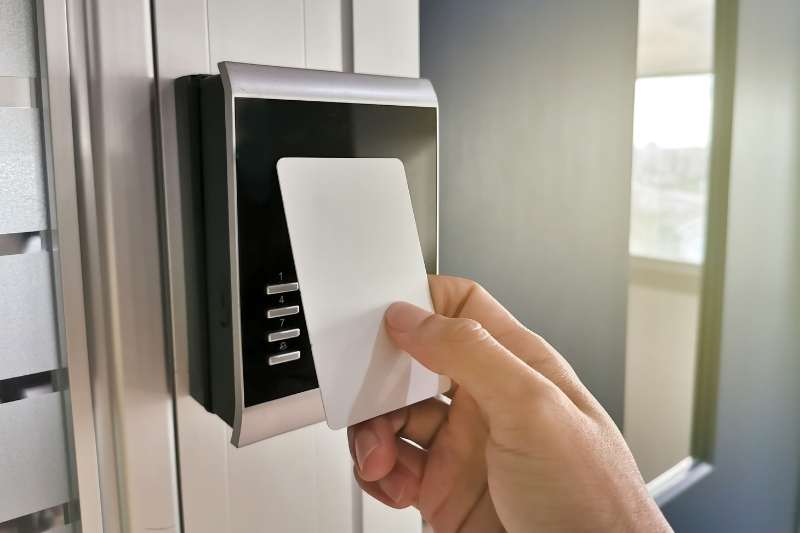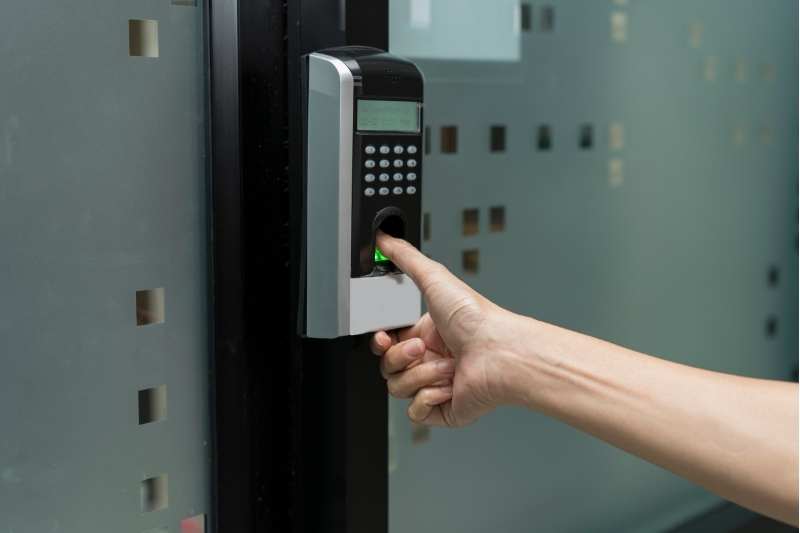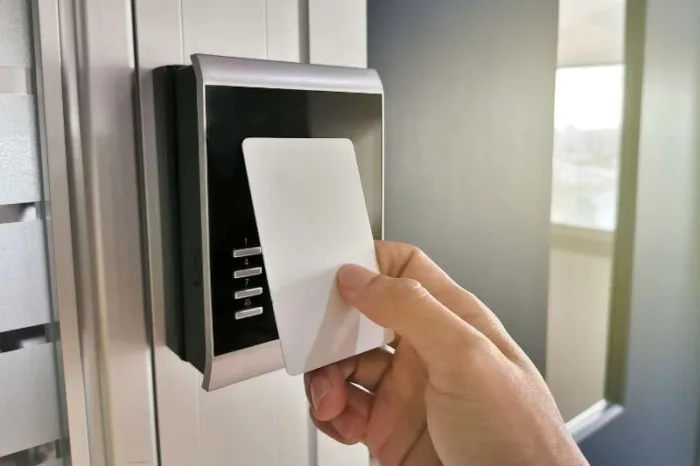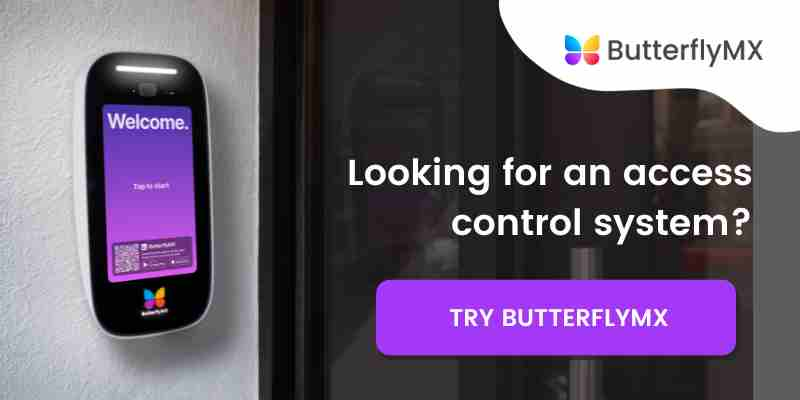Key takeaways
- A Wiegand access control system uses magnetic fields to establish a connection between a credential and a reader.
- While Wiegand readers are simple to use and integrate into other systems, getting a new Wiegand card is a major hassle.
- If you invest in a Wiegand door controller, you might want to supplement it with other access control solutions, like keypads or smart intercoms.

When you’re in charge of controlling access at your property, you have to balance your property’s need for security with a quick and easy access experience for tenants and their guests. These days, you can choose from a lot of systems that claim to offer the best of both worlds — including key card and fob solutions like Wiegand access control.
But will Wiegand access control benefit your property? In this post, we explain what Wiegand access control is and how it works. Then, we go over its pros and cons and list some alternative access solutions to consider.
This post covers:
- What is Wiegand access control?
- How does a Wiegand device work?
- Wiegand access pros and cons
- The right alternative to Wiegand access control
- Wiegand FAQs
What is Wiegand access control?
Wiegand access control is a method of electronic access that uses magnetic fields to transmit data from a credential to a reader. More specifically, Wiegand access depends on a special type of wire called Wiegand wire, which has unique magnetic properties.
In addition to access control systems, you can find the magnetic properties of Wiegand’s wires in many other use cases, including tachometers, gas meters, and rechargeable batteries in medical devices.
A Wiegand access control system includes these parts:
- Credentials. Wiegand credentials are usually a part of key cards, fobs, or badge entry systems.The data stored for these credentials using a Wiegand device can be difficult to erase or alter using normal magnetic fields, making them highly secure and tamper-resistant.
- Reader. One of the most important components of a Wiegand card reader is a coil that generates a magnetic field. When a Wiegand card comes in contact with the reader, the coil makes the wires on the credential release a burst of energy that can be read.
- Control panel. The control panel contains an electronic database of credential information. The reader sends info to the Wiegand access control panel. Then, it compares the data it receives against its database and directs the door or gate to open if there’s a match.
- Door lock. A Wiegand door lock disengages when it receives an electrical signal from the control panel. The Wiegand access control system’s combination of secure credentials, reliable readers, and control panels creates an efficient security solution.
Watch how the ButterflyMX keypad works:
How does a Wiegand device work?
A Wiegand access control system works by transmitting data from the wires on a Wiegand credential to the reader. This data transfer happens because of the Wiegand effect. When a Wiegand card comes in contact with the reader, the coil makes the wires on the credential release a burst of energy that can be read.
Key aspects of how a Wiegand device works include:
The Wiegand effect
At the heart of Wiegand access control is the Wiegand effect, where specially treated wires exhibit unique magnetic properties. These wires generate predictable voltage pulses when exposed to a magnetic field, forming the basis for data transmission in Wiegand devices. This principle ensures that Wiegand systems are both secure and resistant to interference, making them ideal for environments where reliability is critical.
26-bit Wiegand protocol
The 26-bit Wiegand protocol is one of the most widely used standards in access control systems. This protocol includes a structured format of 8 bits for the facility code, 16 bits for the unique card number, and 2 parity bits for error detection. Its simplicity and standardization have made it a popular choice for manufacturers and integrators, ensuring compatibility across various devices and systems.
HID proximity cards
HID proximity cards are a prominent implementation of Wiegand technology, commonly used for secure access in both residential and commercial properties. These cards contain embedded Wiegand wires that store and transmit unique identification data. Their convenience, durability, and compatibility with existing Wiegand systems make them a staple in modern access control.

Wiegand access pros and cons
Wiegand access control systems may help manage property access, but they aren’t perfect. Here, we outline the advantages and disadvantages of using a Wiegand door controller.
Pros
- Easy to use. A Wiegand access control system can use cards or fobs as its credentials. Using a card is as easy as swiping — which beats fumbling around with an outdated brass key! Additionally, property managers can choose a wireless Wiegand reader to simplify installation.
- Secure. A hacker might be able to access another type of card that’s powered wirelessly. For example, RFID tags are easy to clone. However, because Wiegand cards use magnets to store their data, they’re harder to copy.
- Easy to integrate with other systems. Wiegand technology still informs the way many of today’s access control companies design their products! Even though other solutions are developed independently, many access control companies choose to encode data with Wiegand reader compatibility. This is because Wiegand was the standard in electronic access control for a long time.
Note: If you have an existing access control system, chances are you can add a Wiegand reader to your key card or fob business security system without any problems.
Cons
- Lack of bidirectional communication. More advanced methods of credential verification, like WiFi-based or Bluetooth-based systems, can change both the credential and the reader. But Wiegand systems don’t support this capability. For example, a newer NFC access control system can record every entry event for both a reader and a tenant’s credential.
- Residents might lose cards or fobs. Residents losing a card is a big deal for a Wiegand system. Property managers who use keys and fobs to secure their property are undoubtedly familiar with one pitfall: constantly replacing credentials as residents move in, move out, or lose theirs.
- Difficult installation. Installation can be expensive and time-consuming due to the specific wiring needed. Furthermore, Wiegand technology is generally not compatible with most other types of access control systems.
The right alternative to Wiegand access control
While traditional Wiegand systems have proven effective, modern advancements have paved the way for migration to cloud-based platforms. Solutions like ButterflyMX’s Access Control System allows property managers to easily upgrade to cloud-based access control and security. This migration offers significant benefits, including remote access management, real-time monitoring, enhanced scalability, and simplified maintenance. Property managers can now leverage these innovations to optimize security and streamline operations.
Here are three reasons ButterflyMX is better than Wiegand devices:
1. Remote management
One of the standout features of the ButterflyMX Access Control System is its remote management capability. You can easily add or remove contacts from the online dashboard, monitor time and date-stamped entry logs, and grant or revoke access from any location using a smartphone or computer. This flexibility eliminates the need for physical presence on-site, enhancing operational efficiency.
2. Easy installation
Ease of installation is another area in which we excel. Our ButterflyMX system retrofits seamlessly with existing infrastructure, requiring only an internet connection and power supply. This straightforward setup reduces installation time and costs compared to the intricate wiring associated with Wiegand systems. What’s more, it’s easy to find certified installers who can further simplify the installation process for you.
3. Multiple entry methods
Furthermore, ButterflyMX supports multiple entry methods, including smartphone access, key fobs, key cards, and PIN codes, catering to diverse user preferences. As a result, tenants never have to worry about how to get into their building or about losing their credentials.
Wiegand FAQs
Here are the answers to your questions about Wiegand devices and access control:
Is Wiegand an RFID?
While Wiegand is not an RFID itself, it is a protocol often used in RFID systems for access control. Further, Wiegand refers to the communication protocol used between card readers and the access control system’s main controller.
So, while a Wiegand protocol is not RFID itself, it is a crucial component of many RFID-based access control systems. Thus, enabling the communication between RFID cards and the access control system.
What frequency is Wiegand?
There is no standard frequency specified for a 26-bit Wiegand protocol, as the frequency can be customized based on the system’s design and the manufacturer’s specifications. However, a common frequency for Wiegand readers is 125 kHz.
Moreover, Wiegand cards and fobs store data in a specific format called the “26-bit format.” Because Wiegand was one of the first electronic access control systems to hit the market, many of today’s manufacturers still use a 26-bit Wiegand format.
Is Wiegand secure?
Yes, Wiegand is secure. However, it’s secure because the credential data that Wiegand keys store is hard-coded into them when they’re created at a factory. So, ordering a new Wiegand card for a resident might be a logistical nightmare as there are some limitations to them, as you’ll see below.

Get your free quote!
Fill in the form below, and we'll email you right back.
Want a free quote?
Fill in the form below, and we'll email you right back.
You’ll be redirected shortly...






